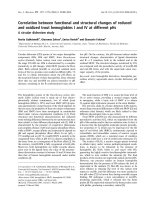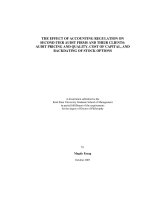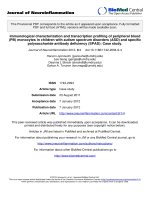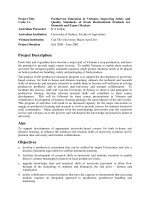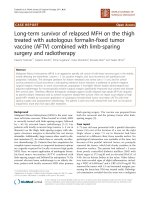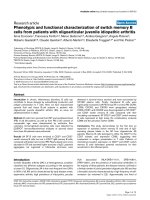Melanosis and quality changes of Pacific white shrimps (Litopenaeus vannamei) treated with Houttuynia cordata extract during cold storage
Bạn đang xem bản rút gọn của tài liệu. Xem và tải ngay bản đầy đủ của tài liệu tại đây (1.1 MB, 5 trang )
Life Sciences | Agriculture
Doi: 10.31276/VJSTE.61(3).40-44
Melanosis and quality changes of Pacific white shrimps
(Litopenaeus vannamei) treated with Houttuynia cordata
extract during cold storage
Dao Thi Anh Phan*, Nga Kieu Thy Vo, Huy Minh Tran, Phan Thi Cam Bui
Department of Chemical Technology, Faculty of Chemical and Food Technology, Ho Chi Minh city University of Technology and Education
Received 8 March 2019; accepted 19 June 2019
Abstract:
Introduction
Changes in melanosis, microbiology, and fat oxidation
in Pacific white shrimps (Litopenaeus vannamei) when
treated with Houttuynia cordata extract (designated
E-DC) were monitored during cold storage for seven
days at 20C. Whole shrimps treated with E-DC solution
(0.025%, w/v) revealed slow growth of total aerobic
microorganisms, Enterobacteriaceae and Pseudomonas
aeruginosa, throughout cold storage in comparison to the
control sample treated by water (p<0.05). The changes
in pH, grey value, and TBARS value (thiobarbituric
acid reactive substances) of shrimp samples treated
with 0.025% E-DC solution were lower than those of
control samples (p<0.05) and not different significantly
in comparison to the 1.25% (w/v) sodium metabisulfite
(SMS) samples (p>0.05). These results suggested the
potential of using natural compounds from vegetable
extraction as a safe and effective alternative for
commercial chemical-derived preservatives in shrimp
storage.
Pacific white shrimps (Litopenaeus vannamei) are an
important commercial product and account for 60% of the
total shrimp exports in Vietnam [1]. However, shrimps are
a highly perishable product because their spoilage begins
soon after death and continues in the storage process.
The discolouration, melanosis development, oxidation,
and microbial spoilage in shrimps are serious problems
affecting the organoleptic, nutritional, and economic
value of the product [2]. Many studies have focused on
preventing melanosis or inhibiting polyphenol oxidase
(PPO) using various techniques such as cold or heat
treatment or additives [3]. Reducing agents such as sulfiting
agents and their derivatives are synthesis chemicals that are
widely used for the control of melanosis or browning in
the food industry. Melanosis is activated by a biochemical
mechanism that oxidizes phenol part in tyrosine to
quinones by tyrosinase enzyme [4]. In commerce, sodium
metabisulfite (SMS) has been used to retard melanosis
development by combining irreversibly with quinones
and forming colourless compounds [3]. However, SMS is
known to cause allergic reactions and severe disturbances in
asthmatic subjects [5]. In recent times, increasing attention
has been paid to plant phenolics as potential natural
preservatives with antioxidant and antimicrobial activities.
Natural antioxidant compounds such as ascorbic acid,
citric acid, kojic acid, gallic acid, dodecyl gallate, catechin,
and oxalic acid have been substituted for sulfiting agents
[2, 3]. Additionally, many studies have reported that extracts
prepared from mushrooms and grapeseed can reduce black
spots in shrimps [6, 7].
Keywords: antimicrobial, Houttuynia cordata, Litopenaus
vannamei, melanosis, oxidation.
Classification number: 3.1
Houttuynia cordata is a well-known, traditionally
medicinal material as well as a commonly used spice in
*Corresponding author: Email:
40
Vietnam Journal of Science,
Technology and Engineering
September 2019 • Vol.61 Number 3
Life Sciences | Agriculture
food. ‘Diếp cá’, ‘lá giấp’, ‘rau giấp’, and ‘giấp cá’ are local
names of H. cordata in Vietnam. In traditional medicine,
H. cordata is administered to relieve fever, resolve toxins,
reduce swelling, and promote urination [8]. Recently,
several studies also provided scientific data about its
anti-SARS, anti-inflammatory, anti-allergic, virucidal,
antileukemic, anti-oxidant, anti-cancer, and anti-tyrosinase
activities [9, 10]. It was noticed that H. cordata contains
groups of such chemical components as flavones, essential
oils, and alkaloids [10-12]. This study aims to investigate the
inhibition of melanosis and quality changes of Pacific white
shrimps treated with E-DC solution during cold storage to
exploit the natural extracts from the spicy vegetables that
are rich in phenolic compounds as an initial treatment step
in the cold-storage process for shrimps.
Materials and methods
Chemical and raw materials
Malonaldehyde bis (dimethyl acetal) and thiobarbituric
acid (TBA) were purchased from Sigma-Aldrich (USA).
Trichloroacetic acid (TCA) was obtained from Merck
(Germany). Other chemicals were of the highest grade
available.
H. cordata was collected at supermarkets in July 2018.
The voucher samples were preserved at the Department of
Food Technology of the Ho Chi Minh city University of
Technology and Education.
White shrimps (L. vannamei) with the size of 30-40
shrimps/kg were purchased from Thu Duc market, Ho Chi
Minh city, Vietnam, in September 2018. The shrimps were
kept alive and transported to the laboratory.
five to seven days. Three shrimps from each treatment
were examined in seven days to determine pH, melanosis
development, lipid peroxidation, inhibition assays, and
microbiological analysis.
pH measurement
The changes in pH values in shrimps during cold
storage were determined by the method of Lopez-Caballero
with a slight modification [13]. Shrimp meat (2 g) was
homogenized by deionized water for one minute, and the
homogenate was kept at room temperature for 5 minutes.
The pH values in shrimps were measured using a pH-meter
(PSI pH 1200, England).
Melanosis evaluation
Fifteen student candidates from the Departments of
Chemical Engineering and Food Technology (ages 19-22)
were recruited to serve as panellists and were trained carefully
in the ability to recognize and describe the common aroma.
Control samples and shrimp samples (treated by SMS, E-DC)
were evaluated throughout storage and classified according to
the level of black-spot development. Grey values in shrimps
were detected directly using a modified Montero sensory
evaluation and evaluated on the point scale from 0 to 10
based on total surface area of affected shrimps as follows: 0
points = no point; 2 points = light (about 20% of the shrimp’s
surface affected); 4 points = average (accounting for 20-40%
of the shrimp’s surface affected); 6 points = significant (40
to 60% of the shrimp’s surface affected); 8 points = highly
severe (60 to 80% of the shrimp’s surface affected); and 10
points = significantly severe (accounting for 80-100% of the
shrimp’s surface affected) [3].
Lipid peroxidation inhibition assay
Preparation of samples
The dried powder of H. cordata leaves (50 g) was
extracted with ethanol solvent to yield an ethanol extract
via the Soxhlet system. Then, the extract solutions were
evaporated under reduced pressure to dry and recover the
ethanol extract (E-DC, 15 g).
Preservation of shrimps
At room temperature (32±20C), the shrimp (L. vannamei)
samples were immersed in various solutions, including
0.025% E-DC solution, 1.25% SMS solution, and water
(control sample) for five minutes. Then, shrimp samples
were taken out and preserved in a plastic box at 20C. To
speed up melanosis development, lipid peroxidation, and
bacterial formation, the shrimps were stored at 20C after
Malonaldehyde bis (dimethyl acetal) (MDA) is
considered to be the final product of the lipid peroxidation
process. MDA forms a pink complex with TBA with the
stoichiometry of 1:2, which can be detected at 532 nm
using a spectrophotometer (Hitachi UH-530, Japan) [14].
Shrimps were ground by a blender and mixed with 10
ml of 7.5% TCA to produce a mixture. The filtrate was
collected and mixed with 0.02 M TBA solution at 1000C
for 15 minutes. Absorbance was measured at 532 nm by
the spectrophotometer. The lipid peroxidation inhibition
ability of the samples was expressed by the TBARS values
(thiobarbituric acid reactive substances), which were
calculated from a standard curve built at concentrations
from 0.01 to 0.05 µM and reported as mg MAD/kg of
September 2019 • Vol.61 Number 3
Vietnam Journal of Science,
Technology and Engineering
41
Life Sciences | Agriculture
shrimp. TBARS values were computed from the mean
values of data from three determinations.
Microbiological analysis
Total aerobic microorganisms, Enterobacteriaceae and
Pseudomonas aeruginosa, in shrimp samples after five days
preserved at 40C were determined based on bacterial count
method following TCVN 5518-2:2007 (ISO 21528-2:2004)
and 3347/2001/QD-BYT at Pasteur Institute in Ho Chi
Minh city.
Statistical analysis
Results were calculated to the analysis of variance
(ANOVA) whereas the Tukey’s test (p<0.05) was applied so
that the means could be compared. Statistical calculations
were carried out by SPSS 15.0 for Window Evaluation
Version (IBM Corporation, USA).
Results and discussion
pH measurement
Changes in pH of white shrimps with and without
different treatments during cold storage are illustrated
in Fig. 1. The pH values of all shrimp samples increased
significantly as the preservation time was extended. On the
first day, the pH values of all samples were not significantly
different (p>0.05). After seven days of storage, the samples
treated with water had the highest pH, followed by those
treated with E-DC, and the SMS sample, respectively
(p<0.05). At the end of storage (on the seventh day), shrimp
samples that were treated with water, 1.25% SMS, and
0.025% E-DC had pH values of 7.96±0.10, 7.49±0.10, and
7.43±0.20, respectively. However, the pH values of the
E-DC and SMS samples exhibited no statistical difference
(p>0.05). Several reasons could explain the increase in pH
value in shrimps during cold storage. It could be due to selfdecomposition by endogenous enzymes or it could also be
due to the activity of microorganisms that associate with
the accumulation of basic compounds leading to a higher
pH. Additionally, the hydrolysis of protein produces NH3,
which is also the cause of growing pH [13, 15]. The lower
increase in pH of shrimps treated with E-DC followed the
lower microbial count [3, 13]. The pH value is a critical
target for shrimp evaluation because it significantly affects
the quality of raw shrimps. According to Shamshad (1990),
the accepted pH values in shrimps should not exceed 7.6
[16]. Thus, the E-DC sample can be applied to preserve
shrimps during cold storage.
42
Vietnam Journal of Science,
Technology and Engineering
Fig. 1. The changes in pH in shrimps during cold storage at
20C for seven days. Results are presented as the mean of three
determinations (n=3).
Melanosis evaluation
The development of melanosis in shrimp samples is
exhibited in Figs. 2 and 3. On day 0, there was no change in all
samples (grey value = 0). When storage time increased, the
melanosis scores in all samples increased (p<0.05). Shrimp
samples treated with SMS and E-DC had grey values lower
than the control sample in cold storage and did not display
significant difference (p>0.05). In general, grey values
occurred significantly after three days of preservation. The
considerable differences between the control sample and
the E-DC sample suggested that H. cordata extract (E-DC)
can prevent melanosis development in shrimps during cold
processing. In commerce, SMS has been used in shrimps to
prevent melanosis development by combining irreversibly
with quinones and forming colourless compounds [3].
However, SMS is known to cause allergic reactions and
severe disturbances in asthmatic subjects. The ability of
H. cordata extract to reduce melanosis development can
relate to the high content of total polyphenol compounds in
this plant. The hydroxyl group can participate in reducing
DOPA-chrome to DOPA (L-3,4-dihydroxyphenylalanine),
by providing electrons or by cross-linking with PPO via
hydrogen bonding [13]. These results suggest the potential
of using natural compounds from vegetable extraction as
a safe and effective alternative for commercial chemicalderived preservatives in shrimp storage.
Fig. 2. Changes in the mean grey value in shrimps during cold
storage. Results were presented in terms of mean (n=15).
September 2019 • Vol.61 Number 3
Life Sciences | Agriculture
Preservation time (day)
%
%
Fig. 4. The TBARS value changes of shrimps during preservation
C for seven days.
Fig. 4. The TBARS
value
changes
shrimps
during preservation
at of
2 othree
at 20C for
seven
days. of
Results
are presented
as the mean
Results are presented
as
the
mean
of
three
determinations
(n=3).
determinations (n=3).
Microbiological analysis
Microbiological analysis
Table 1. The result of microbiological analysis of shrimp samples after five days.
Table 1. The result of microbiological analysis of shrimp samples
Control
E-DC
after five days.
th
Criteria (Cfu/g)
1st day 5th day 1st day 5 day
Control
E-DC
6
5
5
(Cfu/g)
Total aerobic Criteria
microorganisms
5.7x105 1.1x10
1st day 5.7x10
5th day 5.8x10
1st day
720
PseudomonasTotal
aeruginosa
aerobic microorganisms
Pseudomonas aeruginosa
6000
Fig. 3. Development of melanosis in shrimps during cold Enterobacteriaceae
storage.
Enterobacteriaceae
Fig. 3. Development of melanosis in shrimps during cold storage.
Lipid peroxidation
inhibition assay
Lipid peroxidation
inhibition assay
<105.7x105 720
1.1x106 <10
5.7x105
30 720
<10: not detect.
6000
<10
6000
30
10720
6000
5th day
5.8x105
<10
10
<10: not detected.
Results demonstrated that the total aerobic macrobiotic of the control sample (1.1x106
The results of the lipid peroxidation inhibition assay are illustrated
in Fig.
In Results demonstrated
Cfu/g)
was 4.approximately
two times higher
than
E-DC
samplemacrobiotic
(5.8x105 Cfu/g) after five
that
thethetotal
aerobic
The
results
thesample
lipidwere
peroxidation
inhibition
assay
6
general, TBARS
values
of theof
SMS
the lowest, followed
by the
E-DC,
and
the
days (Table 1).
the sample
shrimps (1.1x10
treated with
E-DC was
were approximately
able to inhibit the growth of
Cfu/g)
of Therefore,
the control
are illustrated
Fig.the4.first
Intwo
general,
TBARS values
of
themicroorganisms
aerobic
better than
than the
those
in sample
the control
sample.
According
control sample,
respectively. in
During
days of preservation,
TBARS
values
did not
5
two times higher
E-DC
(5.8x10
Cfu/g)
after to TCVN
5289:2006
of frozen seafood, total aerobic bacteria should not exceed 106 Cfu/g.
differ significantly
(p>0.05).were
The TBARS
values offollowed
SMS and E-DC
samples
wereand
foundrequirements
to be
SMS sample
the lowest,
by the
E-DC,
five
days
1).treated
Therefore,
shrimps
treated
withthe
E-DC
Thus,
ittocan
be
seen
that(Table
samples
with the
E-DC
are suitable
while
control sample is
higher from
first day sample,
to the fifthrespectively.
day and decreased
significantly
from two
the
fifth
seventh
thethecontrol
During
the first
days
were
able to inhibit
therevealed
growth of
aerobic
microorganisms
o
not
acceptable.
Additionally,
results
that
the
numbers
of
P.
aeruginosa and
day of storage at 2 C. Additionally, the TBARS value of the control sample reached a peak
of preservation, TBARS values did not differ significantly
better
than
those
in
the
control
sample.
According
to
TCVN
Enterobacteriaceae
in
the
E-DC
sample
were
lower
than
in
the
SMS
sample
and declined
value on the fourth day and declined over the next three days. The maximum of the TBARS
significantly
after
five
days
in
the
cold
preservation.
P.
aeruginosa
and
Enterobacteriaceae
5289:2006
requirements
of
frozen
seafood,
total
aerobic
(p>0.05).
The
TBARS
values
of
SMS
and
E-DC
samples
values after the fifth day for the E-DC sample, the SMS sample, and the control sample were
are two
common
pathogenic
in6 cryopreservation
[17]. From this, it
bacteria
shouldmicroorganisms
not exceed 10
Cfu/g. Thus, itproducts
can be seen
foundand
to 4.82±0.35
be highermgfrom
the first
day torespectively.
the fifth
day
3.62±0.23,were
3.56±0.24,
MDA/kg
of shrimps,
The
rising
can be concluded
that
E-DC
can
inhibit
harmful
microorganisms
andthe
aerobic
bacteria such as
that
samples
treated
with
E-DC
are
suitable
while
control
TBARs values
days) in the
first stage werefrom
caused
a powerful
process of
fat oxidation,
and (0-5
decreased
significantly
thebyfifth
to seventh
of
P. day
aeruginosa
and Enterobacteriaceae more effectively than seen in the control samples.
sample is not acceptable. Additionally, results revealed
the product
of the fat
such as hydroperoxide
that oxidized
into secondary
the TBARS
value ofquickly
theSeveral
control
storage
at oxidation
20C. Additionally,
previous studies have demonstrated that essential oil extracted from H. cordata
products such as aldehyde. Under the effect of enzymes and microorganisms,
the
secondary
that the numbers
P. aeruginosa
and Enterobacteriaceae
antimicrobial
compoundsofsuch
as methyl nonyl
ketone, bornyl acetate, myrcene,
reachedtoabepeak
value
the fourth
andtocontain
declined
oxidation sample
products continue
converted
to on
all other
products,day
leading
reducedacetic
TBARS
inacid
thegeraniol
E-DC ester,
sample
were lower
thandecanal,
in the dodecanal,
SMS sample
pinene,
camphene,
sabinene,
3-oxo-dodecanal,
next
threethatdays.
of the oxidation
TBARSof fatand
value [6].over
These the
results
revealed
E-DC The
is ablemaximum
to slow the process
inlimonene,
declined
significantly
after
five tetradecanoyl-phorbol-acetate,
days in the cold
caryophyllene,
4-terpineol,
terpineol,
geraniol,
and
shrimps during
coldafter
processing.
values
the fifth day for the E-DC sample, the
SMS preservation.
tetradecanoyl
ester [12]. Among
them, ketones
of methyl nonyl can inhibit
P. aeruginosa
and Enterobacteriaceae
are twothe growth of
Escherichia coli
- an aerobic
bacterium
often occurs in
in cryopreservation
shrimps. Decanal-β-dicarbonyl
sample, and the control sample were 3.62±0.23, 3.56±0.24,
common
pathogenic
microorganisms
compound has also been reported to be a major antimicrobial ingredient in essential oil from
and 4.82±0.35 mg MDA/kg of shrimps, respectively. The products [17]. From this, it can be concluded that E-DC can
H. cordata [18].
rising TBARs values (0-5 days) in the first stage were caused inhibit harmful microorganisms and aerobic bacteria such as
Conclusions
by a powerful process of fat oxidation, the product of the P. aeruginosa and Enterobacteriaceae more effectively
fat oxidation such as hydroperoxide that oxidized quickly than seen in the control samples. Several previous studies
have
demonstrated that essential oil extracted from H.
5
into secondary products such as aldehyde. Under the effect
cordata contain antimicrobial compounds such as methyl
of enzymes and microorganisms, the secondary oxidation nonyl ketone, bornyl acetate, myrcene, pinene, acetic acid
products continue to be converted to all other products, geraniol ester, camphene, sabinene, decanal, dodecanal,
leading to reduced TBARS value [6]. These results revealed 3-oxo-dodecanal, caryophyllene, limonene, 4-terpineol,
that E-DC is able to slow the process oxidation of fat in terpineol, geraniol, tetradecanoyl-phorbol-acetate, and
tetradecanoyl ester [12]. Among them, ketones of methyl
shrimps during cold processing.
September 2019 • Vol.61 Number 3
Vietnam Journal of Science,
Technology and Engineering
43
6
Life Sciences | Agriculture
nonyl can inhibit the growth of Escherichia coli - an aerobic
bacterium often occurs in shrimps. Decanal-β-dicarbonyl
compound has also been reported to be a major antimicrobial
ingredient in essential oil from H. cordata [18].
Conclusions
This study is the first time that a plant was examined for
its ability to preserve white shrimps. The ethanolic extract
that was prepared from H. cordata leaves retarded melanosis
development, pH value, and lipid peroxidation, and inhibited
harmful microorganisms. Specifically, shrimps treated
with E-DC solution (0.025%, w/v) inhibited the growth
of the total aerobic microorganisms to two times after five
days when compared to the control sample (p<0.05). The
development of two pathogenic microorganisms such as
Enterobacteriaceae and Pseudomonas aeruginosa was
controlled effectively throughout cold storage at 20C. The
changes in pH, grey value, and TBARS value of shrimp
samples treated with 0.025% E-DC solution were lower
than those of control samples (p<0.05) and did not differ
significantly in comparison to the 1.25% (w/v) SMS samples
(p>0.05). The results demonstrated that ethanol extract
prepared from H. cordata leaves can be used as a natural
melanosis inhibitor, an antimicrobial, and an antioxidant
agent for cold-stored shrimps. Additionally, the extract from
H. cordata leaves was applied for the first time as a safe and
‘green’ additive for shrimp preservation.
ACKNOWLEDGEMENTS
The study was supported by the Science and Technology
Incubator Youth Program, managed by the Center for
Science and Technology Development, Ho Chi Minh
Communist Youth Union; the contract number is 22/HDKHCN-VU.
The authors declare that there is no conflict of interest
regarding the publication of this article.
REFERENCES
[1] Vietnam Association of Seafood Exporters and Producers
(2017), Report on Vietnam shrimp exports in 2016.
[2] N.P. Nirmal, S. Benjakul (2011), “Use of tea extracts for
inhibition of polyphenoloxidase and retardation of quality loss of
Pacific white shrimp during iced storage”, LWT - Food Sci. Technol.,
44(4), pp.924-932.
[3] P. Montero, M.E. Lopez-caballero, M. Perez-mateos (2001),
“The effect inhibitors and high pressure treatment to prevent melanosis
and microbial growth on chilled prawns (Penaeus japonicas)”, J.
Food Sci., 66(8), pp.1201-1206.
[4] F.H. Norman, K.S. Benjamin (2000), Seafood enzyme:
44
Vietnam Journal of Science,
Technology and Engineering
utilization and influence on post-harvest seafood quality, CRC Press.
[5] A.J. McEvily, R. Iyengar, S. Otwell (1991), “Sulfite alternative
prevents shrimp melanosis”, Food Technol., 45(9), pp.80-86.
[6] B.E. Angel, F. Fernand, J. Orapint, W. Wanchai, H. Ikuo, O.
Toshiaki (2012), “Application of ergothioneine-rich extract from an
edible mushroom Flammulina velutipes for melanosis prevention in
shrimp: Penaeus monodon and Litopenaeus vannamei”, Food Res.
Int., 45(1), pp.232-237.
[7] S. Haiyan, L. Hua, Gaofengy, F. Xubo (2014), “Effect of grape
seed extracts on the melanosis and quality of Pacific white shrimp
(Litopenaeus vannamei) during iced storage”, Food Sci. Techno. Res.,
20(3), pp.671-677.
[8] T.L. Do (2009), Vietnamese medicinal plants, Medicine
publisher, Vietnam.
[9] F. Jiangang, D. Ling, L. Zhang, L. Hongmei (2013), “Houttuynia
cordata Thunb: a review of phytochemistry and pharmacology and
quality control”, Chin. Med., 4(3), pp.101-123.
[10] S.C. Chou, C.R. Su, Y.C. Ku, T.S. Wu (2009), “The
constituents and their bioactivities of Houttuynia cordata”, Chem.
Pharm. Bull., 57(11), pp.1227-1230.
[11] R. Bauer, A. Proenstle, H. Lotter (1996), “Cyclooxygenase
inhibitory constituents from Houttuynia cordata”, Phytomedicine,
2(4), pp.305-308.
[12] H.M. Lu, Y.Z. Liang, S. Chen (2006), “Identification and
quality assessment of Houttuynia cordata injection using GC-MS
fingerprint: a standardization approach”, J. Ethnopharmacol., 105(3),
pp.436-440.
[13] M.E. Lopez-caballero, O. Martinez-alvarez, M.D.C. Gomezguillen, P. Montero (2007), “Quality of thawed deepwater pink
shrimp (Parapenaeus longirostris) treated with melanosis-inhibiting
formulations during chilled storage”, Int. J. Food Sci. Technol., 42(9),
pp.1029-1038.
[14] R. Singh, S. Arora (2007), “Attenuation of free radicals by
acetone extract/fractions of Acacia nilotica (L.) Willd ex Del”, J.
Chin. Clin. Med., 2(4), pp.196-204.
[15] N. Nirmal, S. Benjakul (2009), “Effect of ferulic acid on
inhibition of polyphenol oxidase and quality changes of Pacific white
shrimp (Litopenaeus vannamei) during iced storage”, Food Chem.,
116(1), pp.323-331.
[16] S.I. Shamshad, Kher-un-nisa, M. Riaz, R. Zuberi, R.B. Qadri
(1990), “Shelf life of shrimp (Penaeus merguiensis) stored at different
temperatures”, J. Food Sci., 55(5), pp.1201-1205.
[17] K.I. Sallam (2007), “Antimicrobial and antioxidant effects
of sodium acetate, sodium lactate, and sodium citrate in refrigerated
sliced salmon”, Food Cont., 18(5), pp.566-575.
[18] X. Duan, D. Zhong, X. Chen (2008), “Derivatization of beta
dicarbonyl compound with 2, 4 dinitrophenylhydrazine to enhance
mass spectrometric detection: application in quantitative analysis of
Houttuynia cordata in human plasma”, J. Mass Spectrom., 43(6),
pp.814-824.
September 2019 • Vol.61 Number 3
